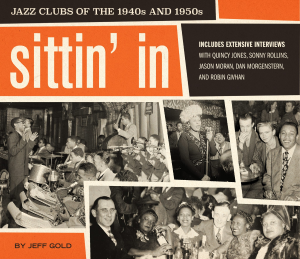.
.
…..Jeff Gold’s book Sittin’ In: Jazz Clubs of the 1940s and 1950s is a visual history of many of the country’s most influential night clubs and ballrooms during jazz music’s golden era.
…..The book is centered around a collection of memorabilia Mr. Gold discovered, and features photographs of club patrons taken by in-house photographers, as well as postcards, handbills, menus, matchbooks, and posters.
…..In cooperation with Mr. Gold, Jerry Jazz Musician will occasionally publish a noteworthy excerpt from the book. In this edition, Gold writes about four Harlem jazz clubs – the Celebrity Club, Club Baron, Palm Cafe, and Club Sudan – and shares photographs and memorabilia from his collection.
.
(Editors note: Readers should keep in mind the context and complexity of the era in which these clubs existed)
.
.
___
.
.
Celebrity Club
35 East 125th Street
.
.
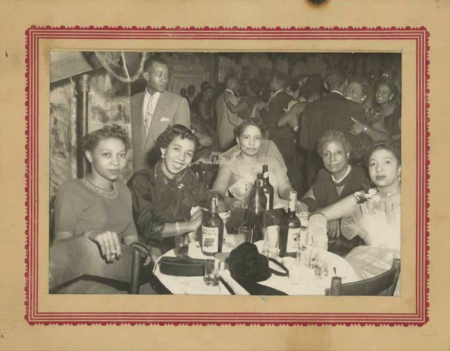
Celebrity Club souvenir photograph, 1940s
.
.
…..When it opened in the mid-1930s, the Celebrity Club was mostly a club for rent, letting out its large basement hall and ground-level room for private events. During at least some part of the 1940s and 1950s, the club didn’t serve liquor but provided “setups” for those patrons who brought their own. The basement room was decorated in “old fashioned Harlem-style – artificial trees topped by bogus leaves in autumn colors.”
…..In the mid-1940s, Art Simms was the house pianist; guitarist Tiny Grimes appeared there too. Beginning in 1953, longtime Count Basie saxophonist Buddy Tate began a residency with his group, the Celebrity Club All-Stars, in the basement room. For the next nineteen years, the group played for dancers, until the club began hosting rock acts in 1974. By the 1980’s, the club was presenting hip-hop, reggae, and dance acts including Madonna, who performed there in 1983. The Celebrity Club is name-checked by rapper Kurtis Blow in his 1983 song “One-Two-Five (Main Street, Harlem, USA).”
.
.

Celebrity Club souvenir photo folder, 1940s
.
.
___
.
.
Club Baron
437 Lenox Avenue at West 132nd Street
.
.
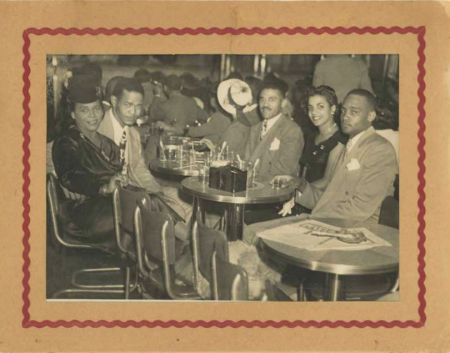
Club Baron souvenir photograph, 1940s
.
.
…..The well-appointed Club Baron opened circa 1940. The club’s owner, John Barone, noted, “I owed my many friends something in return for their patronage…that would offer every, if not more, pleasure than one finds in a Broadway club.” Barone booked African American artists including Ethel Waters, Boston bandleader Sabby Lewis, and Valaida Snow, a multi-instrumentalist nicknamed “Little Louis” after Louis Armstrong, who called her the world’s second-best jazz trumpeter, after himself. At the Baron, the musicians played on a stage behind the bar.
…..Club Baron closed in 1946 but reopened in the 1950s as a community theater where the Committee for the Negro in the Arts produced plays by Black writers. In the 1960s and 1970s, the Baron again became a venue for live music, billing itself as “New York’s Oldest Jazz Club.”
.
.
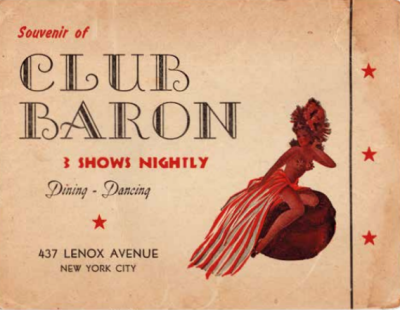
Club Baron souvenir photograph folder, 1940s
.
.
___
.
.
Palm Café
209 West 125th Street Off Adam Clayton Powell Jr. Boulevard (Seventh Avenue)
.
.
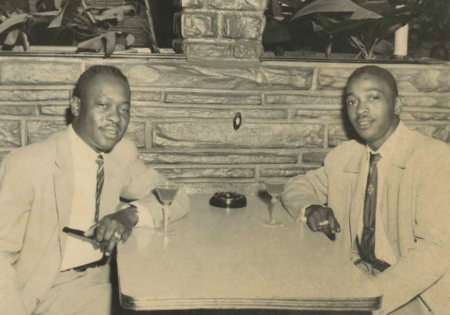
Palm Café souvenir photograph, 1950s
.
.
…..The Palm Café, the self-proclaimed “Most Modern Café and Cocktail Lounge in Harlem,” opened in the early 1940s just down the street from the Apollo Theater. Many of the Apollo’s headliners patronized the Palm, including Cab Calloway and Nat King Cole. Former Palm manager Robert Royal remembered, “It was one of the most popular clubs in New York, and they catered to a sophisticated bourgeois.”
…..In the early 1950s, radio station WOV installed a studio in the club and broadcast programs six nights a week. The programs featured disc jockeys playing records and interviewing celebrities including Sarah Vaughan and Duke Ellington. Billboard noted the radio shows ended each night at three o’clock with a “twelve-minute period of soft lights and sweet music discs.”
…..The Palm closed in the early 1970s.
.
.

Palm Café souvenir photograph folder, 1950s
.
.
___
.
.
Club Sudan
644 Lenox Avenue at 142nd Street
.
.

Club Sudan souvenir photograph, 1946. Pictured at center is legendary drummer Art Blakey, then with Billy Eckstine’s big band
.
.
…..The short-lived Club Sudan opened in the former home of the Cotton Club in November 1945. At the time, Billboard reported that the plan “is to attract white trade to the Harlem spot, so while the hunt for acts is limited by tentative [$5,000] budget, it is ready to put it on the line if it can get names that will pull. Present line-up consists of [dancers] Pops and Louie, [singer] Ann Lewis, [singer] Babe Wallace, Steeplechasers, [dancer and singer] Mable Lee, Leon Abbey Quartet, Andy Kirk’s or and a 12-girl [chorus] line.” Other performers who played the Sudan include Count Basie, Illinois Jacquet, and Billy Eckstine, who played a short stint before the club closed in 1946.
.
.
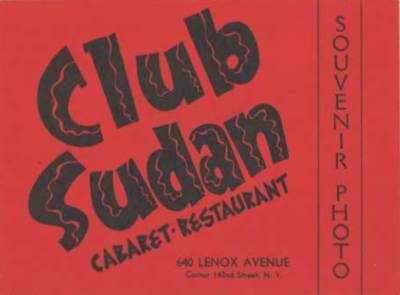
Club Sudan souvenir photograph folder, 1940s
.
.
___
.
.
Click here to read Vol 1, on the Savoy Ballroom
Click here to read Vol 2, on Birdland
Click here to read Vol 3, on Club Ubangi
Click here to read Vol 4, Four Harlem Nightspots
Click here to read Vol 5, on Connie’s Inn and Smalls’ Paradise
.
Click here to read our interview with Jeff Gold
.
.
___
.
.
photo courtesy Jeff Gold
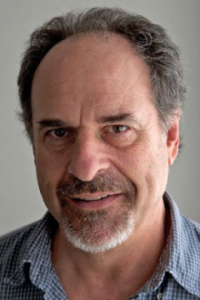
Jeff Gold is a Grammy Award-winning music historian, archivist, author, and executive. Profiled by Rolling Stone as one of five “top collectors of high-end music memorabilia,” he is an internationally recognized expert who has consulted for the Rock & Roll Hall of Fame, Museum of Pop Culture, and various record labels and cultural institutions. He has also appeared as a music memorabilia expert on PBS’s History Detectives and VH1’s Rock Collectors. His other books include 101 Essential Rock Records: The Golden Age of Vinyl from the Beatles to the Sex Pistols and Total Chaos: The Story of the Stooges/As Told by Iggy Pop. He own the music memorabilia website Recordmecca.com and writes about topics of interest to collectors on its blog.
Follow Jeff on Twitter at @recordmecca or on Instagram at @recordmecca.
.
.
___
.
.
All text and images — unless otherwise noted — © Jeff Gold. Excerpted from Sittin’ In: Jazz Clubs of the 1940s and 1950s (Harper Design). Published by permission of Jeff Gold.
.
.
.




